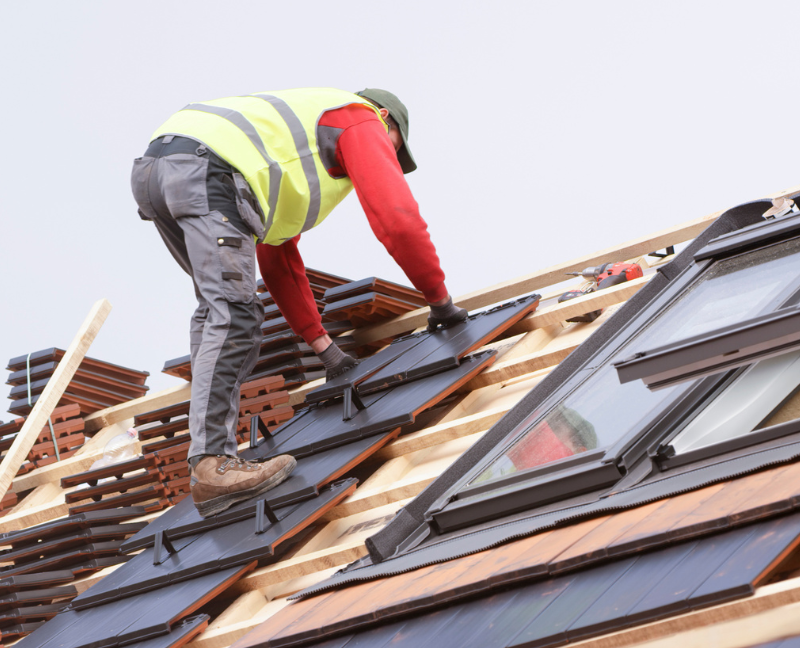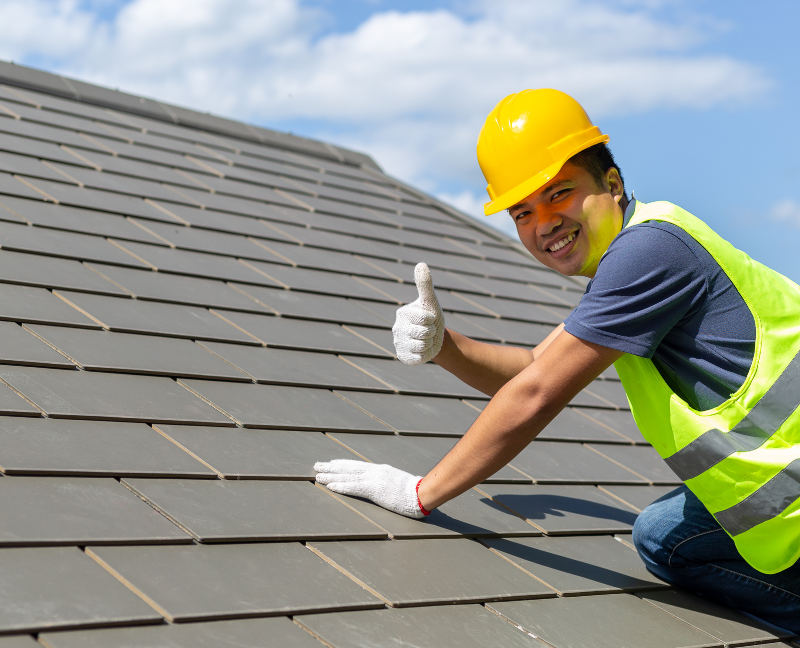There are several considerations to consider when selecting a roof for your house, including cost, durability, and visual appeal. A tile roof is a common choice that satisfies each of these requirements.
In this post, we will talk about what a tile roof is, its types, advantages and disadvantages, and alternative roofing materials.
What Is A Tile Roof?
An array of roofing materials, such as clay, concrete, slate, and metal, are used to create tiles for a tile roof. Tile roofs have a long and remarkable history that dates back to the time of the ancient Greeks and Romans. They are well-known for their endurance and esthetic beauty.
Basically, a variety of colors and styles are available in clay tiles (particularly the well-liked Spanish and French tiles), slate tiles, and concrete tiles. These styles range from conventional barrel or mission tiles to contemporary flat tile designs.
With so many different tile options, any property can be tailored to complement a variety of architectural designs. Because of their strength, energy efficiency, resilience to fire and weather, and longevity, concrete and clay tile roofing are among the most popular types of tile roofing.
Pros Of Tile Roofs
There are many benefits to using roof tiles, but these are the main ones.
Durability And Extended Life
One of the most significant advantages of tile roofing is its extended lifespan. A tile roof can endure several decades if it is installed and maintained properly. The robust individual tiles withstand severe weather conditions and are not prone to insect damage or rot, in contrast to wood shakes or cedar shake roofs.
Furthermore, replacement tiles are an easy way to fix a broken tile on a roof without rebuilding the entire structure.
Insulation And Energy Efficiency
Energy-efficient roofing materials are tile roofs. Their innate ability to breathe and resist heat helps to keep interior temperatures constant, which lowers energy expenses.
They are perfect for both cold areas with freeze-thaw cycles and hot climates with severe temperature changes, such as Central and South Florida. Homeowners who care about the environment can also benefit from solar energy and solar roof tiles.
Visual Appeal And Customization Possibilities
The distinctive, upscale appearance of tile roofing improves a home's curb appeal. A homeowner's architectural components can be enhanced by the tile material and style they select, thanks to the vast choice of colors and styles available, including custom roof tiles.
Metal tiles, for example, may appear sleeker and more current than clay tiles, which have an organic, earthy aspect. The huge assortment of color possibilities makes it simple to get a tile roof that matches your taste and style.
Resistance To Fire And Weather
Since tile roofs are Class A fire-rated, they offer the best fire protection available. They are also resistant to extreme weather, such as strong winds, hail, and torrential rain. Certain tile roofs have been seen to survive winds of up to 150 mph. Tile roofs are perfect for areas that are vulnerable to natural disasters because of their level of resilience.
In addition to these advantages, tile roofs also resist mold and insect damage. Additionally, since most tiles are constructed of natural materials and can be recycled at the end of their useful lives, they are environmentally friendly.

Cons Of Tile Roofing
Even though tile roofs have many advantages, homeowners should consider any potential disadvantages before deciding.
The Initial Cost Of Installation
Generally speaking, tile roofs are more expensive than other common roofing materials like wood shakes or asphalt shingles. The type of tile, the complexity of the roof, and labor costs can all have a significant impact on the average cost per square foot. However, given tile roofs' long lifespan and durability, this initial outlay can be justified.
Brittleness And The Possibility Of Breaking
Even though they are long-lasting, individual tiles might break easily when struck by falling objects or when there is a lot of foot activity. Homeowners should restrict foot activity on tile roofs and hire a roofing contractor for routine maintenance and inspections.
Structural And Weight Considerations
Particularly those made of clay or concrete, tile roofs are big. Due to the weight of clay or concrete tiles, which can approach 1,000 pounds per square foot, roof reinforcing may be required prior to installation. Homeowners should inspect the structural soundness of their homes before adding a tile roof.
Contrasting Asphalt Shingle Roofs With Tile Roofs
Asphalt shingle roofs are a popular and affordable roofing material consisting of a fiberglass foundation covered in granulated asphalt and mineral aggregates.
Asphalt shingles may have a shorter lifespan than tile roofs—an average of 20 years as opposed to 50–100 years for tile roofs. This shortened lifespan could lead to higher replacement expenses more frequently.
Since tile has superior insulation and thermal resistance than asphalt shingles, tile roofs are often more energy-efficient than asphalt shingles. In addition, tiles are recyclable, composed of natural materials, and more environmentally friendly than asphalt shingles, which are petroleum-based products.
However, since asphalt shingles are lightweight and available in a variety of colors and patterns, no additional structural reinforcements are required. Furthermore, compared to tile roof installation or repair, asphalt shingle maintenance is usually less expensive and simpler to undertake.
Metal Roofs Vs Tile Roofs
Metal roofs are famous for their endurance, durability, and weather resistance because they are made of steel, aluminum, or copper.
Both tile and metal roofs are strong and long-lasting; metal roofs have a 70-year lifespan in certain cases. Similar to tile roofs, metal roofs provide exceptional resilience to weather and fire. Nevertheless, because metal roofs are significantly lighter than tile roofs, no structural reinforcements are required.
Regarding energy efficiency, both kinds of roofs function admirably. In hotter regions, metal roofs can reflect solar heat and save cooling expenses, particularly when coated with a reflective layer.
Metal roofs may be noisy, particularly in the event of rain or hail. Tile roofs, on the other hand, are usually quieter.
Slate Roofs Vs And Tile Roofs
Slate roofs are known for their extraordinary longevity, classic beauty, and extended lifespan since they are made from real slate tiles. With the right care, slate and tile roofs can both endure up to 100 years or longer. They are both renowned for their strength and longevity. Slate roofs, however, could require less upkeep than tile roofs since they shatter less easily.
Slate provides a timeless, elegant aesthetic that raises the curb appeal and property value of the house. Conversely, tile roofs come in a wider variety of designs and hues, allowing homeowners to match their roofs to the architectural style of their house as well as their personal preferences.
Since slate and tile roofs are both heavy, roof strengthening may be required before installation. Some varieties of slate require up to 1,500 pounds of structural support per square, making them especially bulky.
Are You A Good Fit For A Tile Roof?
When determining if a tile roof is the best option for your house, there are several things to take into account.
- Budget And Long-Term Investment: Although a tile roof may initially cost more than other roofing materials, over time its longevity and durability may make it a more affordable option.
- Climate And Weather: Tile roofs are highly resilient to fire and severe weather, and they function well in a variety of climates. Although they may function effectively in cold settings with freeze-thaw cycles, they are especially well-suited to hot climates.
- Home Style And Architectural Compatibility: Tile roofs complement the architectural style of any home because they come in a variety of styles and colors. There is a tile roof to fit your style, whether you like the clean design of flat tile or the classic appearance of Spanish tile.
Other noteworthy elements consist of:
- The structural ability of your house to bear the weight of a tile roof
- The requirement for upkeep and the possibility of repair expenses
- Your preference for environmentally friendly, sustainable materials.
Bottom Line
Tile roofs provide a special blend of endurance, toughness, energy economy, and visual appeal. These qualities make them a popular option for homeowners looking for a roofing system that can protect their house while also adding to its aesthetic appeal and market value.
Tile roofs can be more expensive initially than other roofing materials, but they can end up being a wise long-term investment due to their extended lifespan. Their ability to withstand fire, insects, and inclement weather can further add to your peace of mind.
Recall that a high-quality roof adds curb appeal, value, and protection to your property. Consequently, picking the appropriate roof is essential.
To find the ideal property if you're searching for one with a tile roof, talk to us today!

